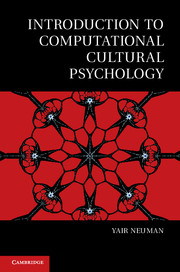Book contents
- Frontmatter
- Dedication
- Contents
- List of Figures
- List of Tables
- Preface
- Acknowledgments
- 1 What is computational cultural psychology?
- 2 The digital psychologist: information technology and cultural psychology
- 3 Why don’t primates have God? Language and the abstraction of thought
- 4 Lost in translation: how to use automatic translation machines for understanding “otherness”
- 5 Spies and metaphors: automatic identification of metaphors for strategic intelligence
- 6 Scent of a woman: the mediation of smell and automatic analysis of extended senses
- 7 Dolly Parton’s love lexicon: detection of motifs in cultural texts
- 8 The relational matrix of the I
- 9 Identifying themes: from the Wingfield family to Harry and Sally
- 10 Eating and dining: studying the dynamics of dinner
- 11 Getting even: the cultural psychology of revenge and what computers can do about it
- Epilogue: on generals and mail coach drivers
- Bibliography
- Author index
- Subject index
1 - What is computational cultural psychology?
Published online by Cambridge University Press: 05 June 2014
- Frontmatter
- Dedication
- Contents
- List of Figures
- List of Tables
- Preface
- Acknowledgments
- 1 What is computational cultural psychology?
- 2 The digital psychologist: information technology and cultural psychology
- 3 Why don’t primates have God? Language and the abstraction of thought
- 4 Lost in translation: how to use automatic translation machines for understanding “otherness”
- 5 Spies and metaphors: automatic identification of metaphors for strategic intelligence
- 6 Scent of a woman: the mediation of smell and automatic analysis of extended senses
- 7 Dolly Parton’s love lexicon: detection of motifs in cultural texts
- 8 The relational matrix of the I
- 9 Identifying themes: from the Wingfield family to Harry and Sally
- 10 Eating and dining: studying the dynamics of dinner
- 11 Getting even: the cultural psychology of revenge and what computers can do about it
- Epilogue: on generals and mail coach drivers
- Bibliography
- Author index
- Subject index
Summary
How real is “culture”? A painful answer
Dr. Samuel Johnson is known for refuting Berkeley’s idealism by stomping his thumb against a solid stone. Whether this anecdote is historically grounded or not is of minor importance. The lesson, however, is extremely important. Some arguments and ideas are refutable or clearly confirmed when they come up against the solid rock of reality. While a naive materialist would consider stones as the hallmark of reality testing, cultural encounters may provide us with a painful experience that confirms the reality of “culture” no less than the reality of stones.
At this point you may intuitively sense my pragmatic approach: it is pain that defines our boundary in encountering reality. To say it differently, let me recall Terry Eagleton, a nonrepresentative of pragmatism, who in his book How to Read a Poem writes (2006, 8): “Reality is what turns its back upon us, resisting our infantile demand that the world should serve as our looking glass.” Well, as the following example teaches us, the world is not the looking glass of our fantasies.
- Type
- Chapter
- Information
- Introduction to Computational Cultural Psychology , pp. 1 - 15Publisher: Cambridge University PressPrint publication year: 2014



